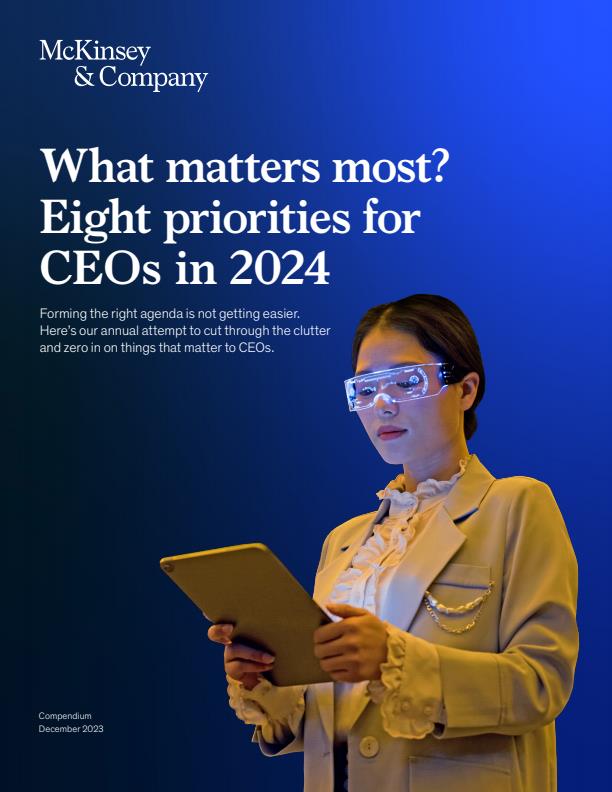What matters most? It’s a question we’ve been investigating for a few years now (here are reports from 2022 and 2021). This year, we’re reminded that what matters most are family, friends, values, principles, and commitments.
One of our commitments is to CEOs. It’s a tough job and getting tougher all the time. Just in the past few years, they’ve had to cope with a global pandemic, busted supply chains, war, stubborn inflation, and many other disruptions. Any one of these is enough to derail a CEO’s agenda. Taken together, it’s the most difficult operating environment we can remember.
Both of us talk to hundreds of CEOs every year, and many of our colleagues do the same. We admire how CEOs are leading their companies for the benefit of all stakeholders. We’ve consolidated the views that have come out of these conversations and are pleased to offer what we’ve heard about how companies can do better for society, communities, and employees—and the prosaic business of how they can pay for it all, and reward investors too.
Here are eight priorities for CEOs in 2024.
Gen AI goes from proof of concept to scale
The biggest story of this year (or decade) was the arrival of generative AI (gen AI). This is the real deal, folks. Thousands of companies in every industry and in every part of the world are already using a simple gen AI interface to radically transform every imaginable business activity. But while innovators dominate headlines, it’s scalers that dominate markets. CEOs need to figure out three things, posthaste: which parts of the business can benefit, how to scale from one application to many, and how the new tools will reshape their industry.
How to outcompete with technology
As the digital era enters middle age, most companies have at least started a digital and AI transformation. But few are getting the results they want; that’s usually because they haven’t done the fundamental organizational rewiring needed to extract maximum value from the hard work of digitizing the enterprise. This year, our colleagues published a bestselling book Rewired: The McKinsey Guide to Outcompeting in the Age of Digital and AI. It’s a collection of our best insights for digitizing the enterprise. Digital winners grow revenues and cut costs faster than others.
The biggest capital reallocation in our lifetime
That’s what we said last year about the energy transition. The bill has only gone up since then, for the simple reason that amid uncertainty, investors and companies have held back from committing their capital, even as the Earth grows hotter. Let’s be clear: what needs to happen is the creation of thousands of new green-technology businesses, in every part of the emerging business system. We have ideas about where, how, and when companies should invest.
What’s your superpower?
Think of any company you admire, and you can likely rattle off one or two superpowers that make it uniquely successful. Toyota and its Toyota Production System. LVMH and its exquisite craftsmanship and the entrepreneurship of its brand leaders. Disney and imaginative customer experiences. A distinctive capability can lift a company out of the mire of clogged, commoditized markets and on to the high ground of outperformance. Exceptional implementation is part and parcel of building a new capability.
Learn to love your middle managers
Waffle House, an American restaurant chain, is famous for never closing; some say its doors have no locks. It should also be famous for its management philosophy. The restaurant’s grill operators are the stars of the show; after years of training, the best get to be called “Elvis of the grill.” After that, they don’t get promoted; how do you top being King? But most other companies would likely promote such people into senior management roles that they don’t want and are not suited for. Companies need to rethink their philosophy about middle managers and recognize them for what they actually are: the core of the company.
Geopolitics: Beating the odds
As Niels Bohr once said, it’s very hard to make predictions, especially about the future. As CEOs watch the changes unfolding in the global geopolitical order, all agree with the sentiment. What comes next? One thing is for sure: events have an uncanny way of defying the expectations of experts. In the face of that, management teams and boards should consider black swans and gray rhinos in their scenarios and build geopolitical resilience that will serve them well, no matter which side of the coin comes up.
Navigating the road to courageous growth
It’s a funny thing: growth is always job one for CEOs, but the path to get there is never clear. Sometimes it’s about seizing market share; sometimes it’s about expanding into new markets; sometimes it’s about making a left turn into something completely new. The one constant is the ten rules of growth. How will the rules play out in 2024? For many, it will mean rule 4: turbocharge your core, by using technology to power growth. For others, it might mean rule 6: grow where you know, by improving sales productivity. And, as always, the most constant of all is rule 9, acquire programmatically, as the latest installment of our 20-year research effort demonstrates.
A new lens on the macroeconomy
Nearly four years after COVID-19 rewrote history, some CEOs are still waiting for macroeconomic certainty. That’s unlikely to happen—and that’s OK. Leading firms capitalize on uncertainty: they assess their risk appetite, then invest near the bottom of cycles. Most rely on scenario planning, not least because the exercise usually reveals the core actions that companies need to take no matter which way the economy trends. CEOs might want to populate their models with the new scenarios we’ve developed to look at the ways the global balance sheet might develop. Over the past two decades, assets on the global balance sheet grew much faster than GDP—the real economy. But the continuation of that trend is uncertain. Yet another curve ball is the rapid shift of assets from the banking system to private markets, and what that means for public companies.
We hope this article and the in-depth readings available within it give CEOs and executives some clarity on the big issues on their 2024 agenda. And don’t forget that CEOs need to look after the little things and take care of themselves too.





